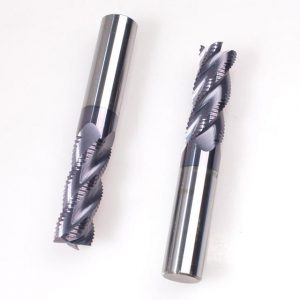
In the milling cutter, the rotation direction of the feed direction of the workpiece tungsten steel milling cutter and the cutting area. The same chip thickness from the start will be gradually reduced, until the incision in the peripheral milling end of the zero check; in inverse milling (also known as reverse milling), the rotation direction of the milling cutter feeding direction of the workpiece and the cutting area is just the opposite. The chip thickness to zero, and then with the cutting process gradually increased.
In inverse milling cutter, tungsten carbide cutter blade from zero chip thickness at the start cutting, it will have a very high cutting force, so as to promote the tungsten steel milling cutter and the workpiece away from each other. The blade is forced into the incision cutter, usually by cutting blade and is caused by the contact machining hardened surface at the same time, friction and polishing effect in friction and high temperature effect. The cutting force is more likely to work off the bench.
In milling cutter, tungsten steel milling cutter blade starts cutting from the maximum chip thickness. It can reduce the heat and decrease machining hardened to avoid polishing effect. The trend of lotus very favorable application of maximum chip thickness and cutting force, the easier it will be to push workpiece tungsten steel milling cutter, the tungsten carbide cutter blade cutting no matter how. Machine tool, fixture and workpiece requirements, milling is the preferred method.
In the milling cutter, cutting sometimes adhered or welded to the cutting edge, and gathered around the starting next cutting. Inverse milling, cutting can be easily intercepted or wedged between the blade and the workpiece, which will lead to blade rupture. And when the milling, the same chip breaking will not damage the cutting edge One divides into two.